|
Haiku Poems and Japanese Food (No.47)
24 March 2014
The Belgian labour situation differs from that of Japan in many aspects. Both have a high youth unemployment rate in common, but Belgium also has an extremely low percentage of working elderly. According to the OECD statistics, the employment rate of persons aged 55 to 64 in Japan is 65%, but only a mere 39% in Belgium. According to a local newspaper, Belgian employers are reluctant to hire elderly workers whose labour costs are relatively high. Also, past the age of 50 the motivation to work dwindles and many people retire early with a retirement bonus and advanced pension pay-outs. Experts point out that there exists a work culture in which for the Belgians “it is, for example, better not to work, even if one’s income drops”. The employment rate of people aged 55 to 64 is over 70% in Nordic countries such as Sweden and Norway, around 40% in South European countries such as Italy and Spain, and 44% in France. Looking at these figures, Belgium seems to belong to the South European and Latin cultural sphere. In addition, the fact that many people can easily leave their jobs because of the unemployment benefits system and the fact that people can be absent from work for a long period of time for reasons such as stress has become a problem. Considering this, concerns are raised about the sustainability of the pension system and the burden on the national budget regarding the labour and social policy. As the income tax is high in Belgium, the net pay of the average employee is in general about 60% of the face-value. And when the tax rate is even higher for overtime pay, one might feel that ‘working is absurd’. If the number of non-workers increases, the government will be compelled to collect more tax from the working population. This would only lead to a vicious circle in which the motivation of the workers declines even further. What do you think?
< The Governor of Walloon Brabant and the Mayor of Turnhout >
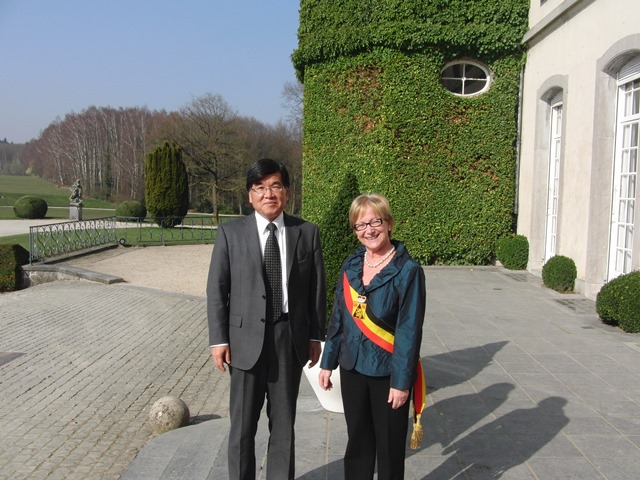 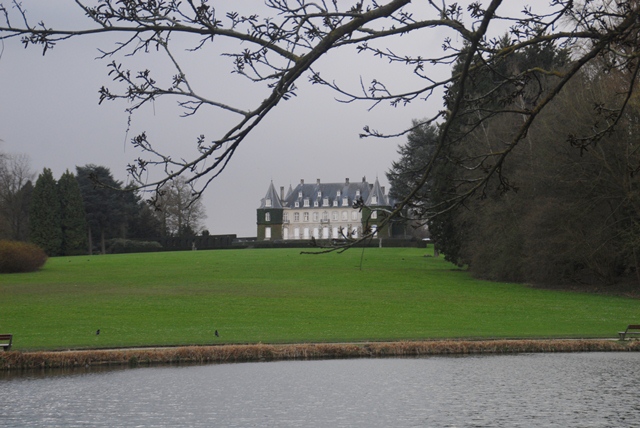 Yesterday I visited the Province of Walloon Brabant located in the south of the Brussels-Capital Region to meet with Marie-Jose Lalloy, governor of Walloon Brabant. The governor did not receive me at the city hall, but welcomed me instead at the Castle of La Hulpe. This castle was built in the 1830’s. After the Solvay family, who were Belgium’s biggest industrial group at the time, bought it at the end of the 19th century as a second residence, they donated the castle to the Walloon regional government in 1963. It is a vast domain of 227ha and is open to the public as a park since 1972. Walloon Brabant was born from the scission of the Province of Brabant in 1995 into a French speaking and Dutch speaking province. It is the smallest province in Belgium and the number of inhabitants is less than 400.000. However, the GDP per capita is the highest in Belgium and you can find splendid houses even in the countryside. As for Japanese companies, in addition to the recent move of the headquarters of AGC Glass to the city of Louvain-La-Neuve, a car parts manufacturer is active in another city. The governor told me that in the midst of the agricultural stagnation in the region they are striving to create a better investment environment by building several industrial parks and that they are hoping for investments from foreign companies. Yesterday I visited the Province of Walloon Brabant located in the south of the Brussels-Capital Region to meet with Marie-Jose Lalloy, governor of Walloon Brabant. The governor did not receive me at the city hall, but welcomed me instead at the Castle of La Hulpe. This castle was built in the 1830’s. After the Solvay family, who were Belgium’s biggest industrial group at the time, bought it at the end of the 19th century as a second residence, they donated the castle to the Walloon regional government in 1963. It is a vast domain of 227ha and is open to the public as a park since 1972. Walloon Brabant was born from the scission of the Province of Brabant in 1995 into a French speaking and Dutch speaking province. It is the smallest province in Belgium and the number of inhabitants is less than 400.000. However, the GDP per capita is the highest in Belgium and you can find splendid houses even in the countryside. As for Japanese companies, in addition to the recent move of the headquarters of AGC Glass to the city of Louvain-La-Neuve, a car parts manufacturer is active in another city. The governor told me that in the midst of the agricultural stagnation in the region they are striving to create a better investment environment by building several industrial parks and that they are hoping for investments from foreign companies.
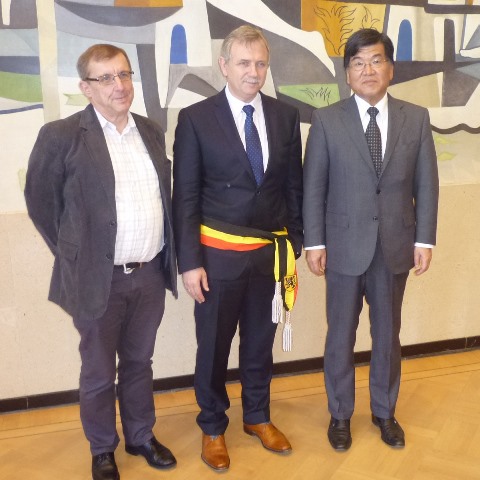 The day before, I paid a courtesy call on Mr Eric Vos, mayor of Turnhout (40.000 inhabitants) which is located in the northeast of Belgium, near the border of the Netherlands. The mayor worked for a local pharmaceutical company for a long time and became mayor of the city last December. The city is home to Cartamundi, the world’s number one manufacturer of playing cards, as well as to Janssen Pharmaceutica, Belgium’s well-recognised pharmaceutical company, and a factory of Philips, a Dutch manufacturer of electronics. According to the mayor, Turnhout is a young city with 30% of the citizens being students. Turnhout’s sightseeing spots are the Beguinage (built in the 13th century), designated as a Unesco World Heritage site, and the Castle of the Dukes of Brabant (13th - 17th century). What I was interested in was the old church (15th - 18th century) in the middle of the main square. Normally this kind of church is built so as to face the main square, thus it is very rare that the church was built in the centre of the square, disturbing the surrounding view. Because of this, I kind of felt that the city hall built in 1961 facing the square was not very present. The day before, I paid a courtesy call on Mr Eric Vos, mayor of Turnhout (40.000 inhabitants) which is located in the northeast of Belgium, near the border of the Netherlands. The mayor worked for a local pharmaceutical company for a long time and became mayor of the city last December. The city is home to Cartamundi, the world’s number one manufacturer of playing cards, as well as to Janssen Pharmaceutica, Belgium’s well-recognised pharmaceutical company, and a factory of Philips, a Dutch manufacturer of electronics. According to the mayor, Turnhout is a young city with 30% of the citizens being students. Turnhout’s sightseeing spots are the Beguinage (built in the 13th century), designated as a Unesco World Heritage site, and the Castle of the Dukes of Brabant (13th - 17th century). What I was interested in was the old church (15th - 18th century) in the middle of the main square. Normally this kind of church is built so as to face the main square, thus it is very rare that the church was built in the centre of the square, disturbing the surrounding view. Because of this, I kind of felt that the city hall built in 1961 facing the square was not very present.
< Two Japanese Companies – AGC Glass and Yakult >
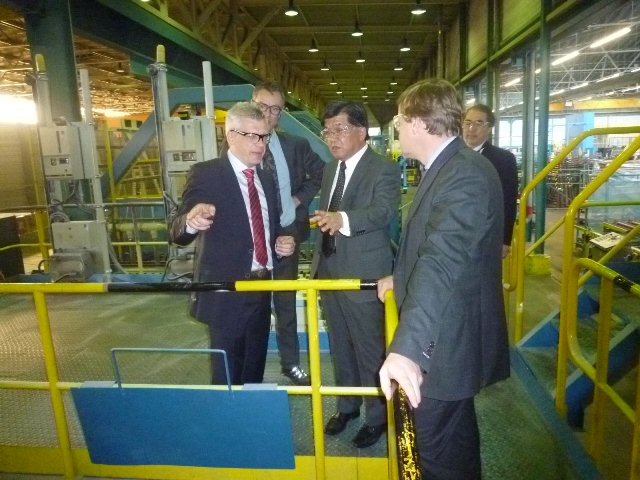 Ten days ago I consecutively visited Japan’s largest and smallest companies in Belgium. The first one was the factory of glass manufacturer AGC Glass situated in the small town of Mol about 80km northeast of Brussels (population: 34,000). This factory with 500 employees was originally part of the Belgian company called Glaverbel and has a history dating back 92 years. Japanese Asahi Glass (founded in 1907) took an equity participation in Glaverbel in 1981 and made it a wholly owned subsidiary in 2002. The factory in Mol has now become one of the main factories of AGC Glass. I was shown the manufacturing process of flat glass – with the so-called float glass technique 0.4 to 4mm-thin sheets of glass are created by heating and dissolving sand (collected locally) over 1400 degrees Celsius, which are then cooled and cut to size appropriately. This manufacturing process takes place in a 300m-long facility and continues to operate all year round, 24h a day, non-stop. AGC Glass produces various glass products such as for use in construction and for use in the automobile sector and has grown out to being the world’s top competitor in its respected field. Besides the factory in Mol, AGC Glass has 14 facilities in Belgium such as the Moustier factory in the south of Belgium (600 employees), with 2500 employees in total. AGC Glass is one of the largest Japanese companies in Belgium. Ten days ago I consecutively visited Japan’s largest and smallest companies in Belgium. The first one was the factory of glass manufacturer AGC Glass situated in the small town of Mol about 80km northeast of Brussels (population: 34,000). This factory with 500 employees was originally part of the Belgian company called Glaverbel and has a history dating back 92 years. Japanese Asahi Glass (founded in 1907) took an equity participation in Glaverbel in 1981 and made it a wholly owned subsidiary in 2002. The factory in Mol has now become one of the main factories of AGC Glass. I was shown the manufacturing process of flat glass – with the so-called float glass technique 0.4 to 4mm-thin sheets of glass are created by heating and dissolving sand (collected locally) over 1400 degrees Celsius, which are then cooled and cut to size appropriately. This manufacturing process takes place in a 300m-long facility and continues to operate all year round, 24h a day, non-stop. AGC Glass produces various glass products such as for use in construction and for use in the automobile sector and has grown out to being the world’s top competitor in its respected field. Besides the factory in Mol, AGC Glass has 14 facilities in Belgium such as the Moustier factory in the south of Belgium (600 employees), with 2500 employees in total. AGC Glass is one of the largest Japanese companies in Belgium.
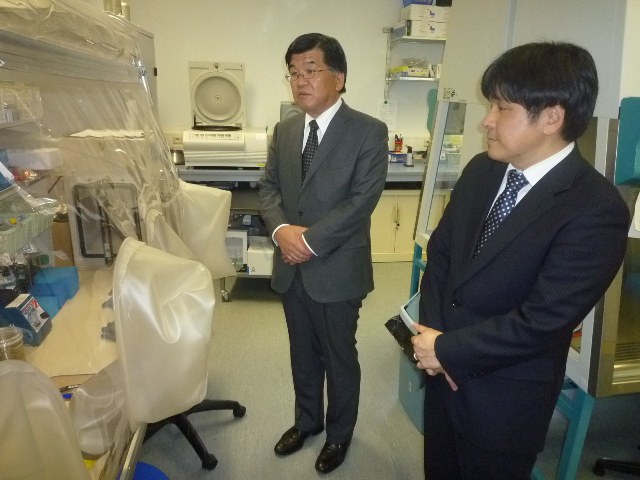 The second company I visited was the headquarters of Yakult’s European Research Centre, situated 50km to the west of Brussels, on the outskirts of Ghent. Yakult is well known amongst Japanese, however is a really strange company – the founder of the company, Dr Minoru Shirota, succeeded in separating and fermenting a kind of lactic acid bacterium, called the ‘Lactobacillus casei shirota strain’ in 1930, which was the pivotal point for the birth of the major company it is today (founded in 1955). By the way, apparently ‘yakult’ is the word for yoghurt in Esperanto. I think the secret of the company’s success lies in the fact that the product itself was highly appreciated as a healthy one. At the same time, the door-to-door sales method, mobilising a large number of women called ‘Yakult Ladies’, and the intestinal flora analysis technique called ‘YIF-SCAN’ were independently develloped. Currently Yakult is also widely sold as a healthy drink in Belgian supermarkets, but the production itself is carried out in the Netherlands. A human body carries 100 trillion bacteria (microorganisms) in its intestines and the aforementioned ‘Shirota strain’ seems to be involved in the activation of bifid bacteria, beneficial microorganisms. A small 65cc bottle of Yakult contains 20 billion of this ‘shirota strain’. It is the task of the European Research Centre (six researchers in total, amongst whom four are Japanese) to prove that these are also healthy for Europeans who have a different physical constitution from Japanese. The second company I visited was the headquarters of Yakult’s European Research Centre, situated 50km to the west of Brussels, on the outskirts of Ghent. Yakult is well known amongst Japanese, however is a really strange company – the founder of the company, Dr Minoru Shirota, succeeded in separating and fermenting a kind of lactic acid bacterium, called the ‘Lactobacillus casei shirota strain’ in 1930, which was the pivotal point for the birth of the major company it is today (founded in 1955). By the way, apparently ‘yakult’ is the word for yoghurt in Esperanto. I think the secret of the company’s success lies in the fact that the product itself was highly appreciated as a healthy one. At the same time, the door-to-door sales method, mobilising a large number of women called ‘Yakult Ladies’, and the intestinal flora analysis technique called ‘YIF-SCAN’ were independently develloped. Currently Yakult is also widely sold as a healthy drink in Belgian supermarkets, but the production itself is carried out in the Netherlands. A human body carries 100 trillion bacteria (microorganisms) in its intestines and the aforementioned ‘Shirota strain’ seems to be involved in the activation of bifid bacteria, beneficial microorganisms. A small 65cc bottle of Yakult contains 20 billion of this ‘shirota strain’. It is the task of the European Research Centre (six researchers in total, amongst whom four are Japanese) to prove that these are also healthy for Europeans who have a different physical constitution from Japanese.
< French Haiku and the Japanese Ambassador’s Prize >
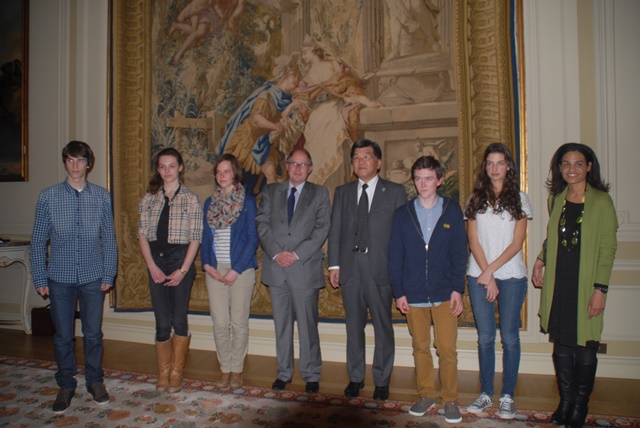 Nowadays haiku is establishing itself as part of the literature in many countries of the world. Enthusiasts of ‘haiku’- called “the world’s shortest poem that Japan gave birth to”, are to be found in more than 70 countries. Over 200 haiku experts from 30 countries have joined the World Haiku Association (its main office is located in Fujimi, Saitama), established in 2000. Just as Japanese ‘judo’ has become widespread worldwide as an Olympic sport, which led to the internationalisation of the rules, we seemingly see the same thing happening with ‘haiku’. However you may have it, be it in English or be it in French, with the exception of the two rules of dividing the poem in three lines and adding in a seasonal word, there is lots of freedom in making up a haiku. The other day in the French Ambassador’s residence in Brussels a French haiku award ceremony was held with the support of our embassy as well. I awarded the best piece with the ‘Japanese Ambassador’s Prize’. Nowadays haiku is establishing itself as part of the literature in many countries of the world. Enthusiasts of ‘haiku’- called “the world’s shortest poem that Japan gave birth to”, are to be found in more than 70 countries. Over 200 haiku experts from 30 countries have joined the World Haiku Association (its main office is located in Fujimi, Saitama), established in 2000. Just as Japanese ‘judo’ has become widespread worldwide as an Olympic sport, which led to the internationalisation of the rules, we seemingly see the same thing happening with ‘haiku’. However you may have it, be it in English or be it in French, with the exception of the two rules of dividing the poem in three lines and adding in a seasonal word, there is lots of freedom in making up a haiku. The other day in the French Ambassador’s residence in Brussels a French haiku award ceremony was held with the support of our embassy as well. I awarded the best piece with the ‘Japanese Ambassador’s Prize’. 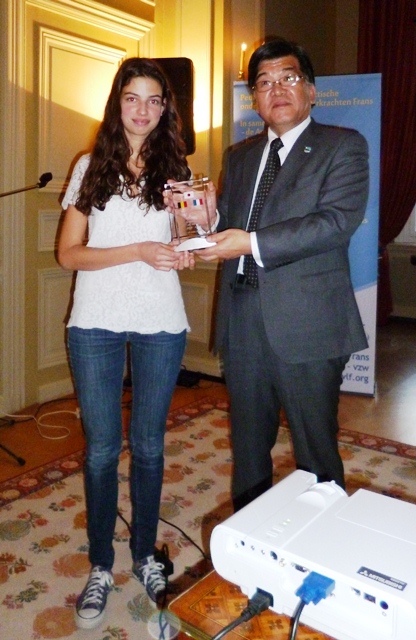 The winning haiku was written by a secondary school student of a girls’ school in Aalst and goes as follows: “Sur les fenêtres du bus, Des traces de nez et de doigts, Regardent la pluie”. It reminds you of a crowded bus commute to school on a rainy day. As part of the support of French language education in Flanders, the Embassy of France seems to have focused on haiku, and their plan succeeded in its own way. Speaking of haiku, about two months ago, a ‘Haiku Mission’ headed by Mr Akito Arima, former president of the University of Tokyo, visited Brussels, and an exchange meeting with famous haiku-enthusiast EU president Van Rompuy and local haiku-lovers was held. That day I received a bottle of red wine from one member of the delegation of which the label unequivocally read ‘Haiku’. Although the wine was from Tuscany in Italy, I forgot to ask why it was named as such. The winning haiku was written by a secondary school student of a girls’ school in Aalst and goes as follows: “Sur les fenêtres du bus, Des traces de nez et de doigts, Regardent la pluie”. It reminds you of a crowded bus commute to school on a rainy day. As part of the support of French language education in Flanders, the Embassy of France seems to have focused on haiku, and their plan succeeded in its own way. Speaking of haiku, about two months ago, a ‘Haiku Mission’ headed by Mr Akito Arima, former president of the University of Tokyo, visited Brussels, and an exchange meeting with famous haiku-enthusiast EU president Van Rompuy and local haiku-lovers was held. That day I received a bottle of red wine from one member of the delegation of which the label unequivocally read ‘Haiku’. Although the wine was from Tuscany in Italy, I forgot to ask why it was named as such.
< Belgium’s Michelin Star Restaurants and Japanese Cuisine >
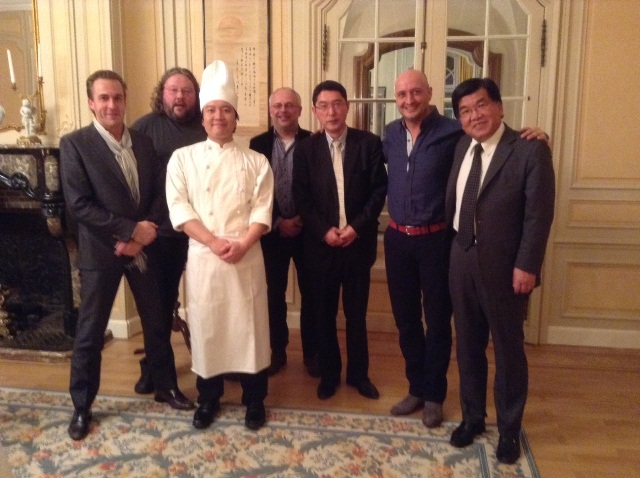 Last week I invited several famous Belgian, Michelin-starred chefs and culinary experts to hold a ‘Let’s talk Japanese Food’ gathering at my residence. Last year the Japanese government started to promote Japan’s traditional cuisine after it was listed by Unesco as an intangible cultural heritage. Last January, the guests I invited to the residence, visited Japan as well under the invitation program of the Ministry of Agriculture. During their stay in Japan they got to taste authentic Japanese food at long-established restaurants in Kyoto and Osaka, and got to visit the markets where all of the ingredients are sold. They not only got to observe the cooking scene at the famous Tsuji Cooking School, but also got trained in how to handle Japanese kitchen knives skilfully themselves, so it apparently was a fulfilling program. The chefs seem to have already incorporated their Japanese inspired ideas into their own restaurants’ menus. The bustling clamour of the trading of fresh living fish early in the morning in the Osaka fish market left a great impression on all of them. They told me that due to the fact that dead fish is being traded in the Belgian fish markets the odour of the fish market was completely different. They were also surprised by the many kinds of vegetables. The food experts wrote a long article on their visit to Japan in the local newspaper. I was told that all of the food in Japan was delicious; especially Yakitori (barbecued chicken on a bamboo skewer) they liked. The only thing that was less well-received seemed to be Oden (vegetables, fish dumplings, tofu and other ingredients stewed in a thin soy soup and served hot). Alas, too bad… Last week I invited several famous Belgian, Michelin-starred chefs and culinary experts to hold a ‘Let’s talk Japanese Food’ gathering at my residence. Last year the Japanese government started to promote Japan’s traditional cuisine after it was listed by Unesco as an intangible cultural heritage. Last January, the guests I invited to the residence, visited Japan as well under the invitation program of the Ministry of Agriculture. During their stay in Japan they got to taste authentic Japanese food at long-established restaurants in Kyoto and Osaka, and got to visit the markets where all of the ingredients are sold. They not only got to observe the cooking scene at the famous Tsuji Cooking School, but also got trained in how to handle Japanese kitchen knives skilfully themselves, so it apparently was a fulfilling program. The chefs seem to have already incorporated their Japanese inspired ideas into their own restaurants’ menus. The bustling clamour of the trading of fresh living fish early in the morning in the Osaka fish market left a great impression on all of them. They told me that due to the fact that dead fish is being traded in the Belgian fish markets the odour of the fish market was completely different. They were also surprised by the many kinds of vegetables. The food experts wrote a long article on their visit to Japan in the local newspaper. I was told that all of the food in Japan was delicious; especially Yakitori (barbecued chicken on a bamboo skewer) they liked. The only thing that was less well-received seemed to be Oden (vegetables, fish dumplings, tofu and other ingredients stewed in a thin soy soup and served hot). Alas, too bad…
|

